This interview explores Althea Thauberger’s experimental digital film Preuzmimo Benčić (Take Back Benčić). The film was made in collaboration with 67 child performers from Rijeka, Croatia. Part documentary, part fiction, the film follows the children’s activities and reflections during a 6 week period when they occupied the H and T buildings of Rijeka’s former worker-managed Rikard Benčić factory. The site had served as a sugar refinery, tobacco processing plant, and ship and motor factory. It now sits empty and deteriorating after being closed and its workers fired during the privatizations of the early 1990s. At the time of filming, the site was proposed as a site for the city’s cultural institutions, “creative industries,” and a hotel. In the film, the children are asked to reflect on the past and potential futures of the factory in a series of theatrical and performative vignettes. As co-creators, the film’s young cast generated and improvised most of the dialogue and movement in the film. Through their words and gestures they re-imagine the politics, histories, and future of the site, and the relationship between work, art and play. LeftEast’s Konstantin Kilibarda interviews Thauberger about the process behind making the film and the main themes addressed.
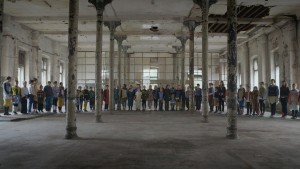
KK: Can we start with a bit of information about Rijeka, the broader context from which the work emerges?
AT: Sure, Rijeka as you know is a post-industrial port city in the north of Croatia but in a way the question of recent history in Rijeka is intrinsically tied to the deep history of the city. Which is kind of the case in the entire region I think. The longer history of Rijeka is that it has been a very important industrial center since the mid 18th Century when the first of the main industries, the sugar refinery, was established. And this is also related to the site where we worked, because the first building on the site was in fact the administrative headquarters of that refinery. Many other industries and factories were established after that, and initially as support industries for this refinery. In terms of its recent history, during the war and privatizations in the early 1990s, a large number of these industries and factories were privatized and/or shut down in a painful and mostly illegal processes. Of course, the workers were fired and let go in very large numbers and this is still a living trauma in the city.
So unlike other coastal cities in the country, Rijeka as a city is not ancient and picturesque – it was developed as an industrial port, and is therefore not really a tourist destination. Also because of its more recent industrial past and as a destination for workers from all over Yugoslavia, it continues to hold on to a left-leaning or even socialist politics. In the last decades this has led to the city being economically and politically alienated, punished even, by the rest of the country and the more dominant right-leaning nationalist interests. Currently there are these very visible reminders and ghosts of its industrial demise, reflected in the city’s remaining built environment through the empty shells of former factories and industrial complexes. Now is a time when the city is in recession, with very high unemployment, like many other places in the region, and is kind of looking for what the next industries will be, for the promise of new economies.
KK: How did you come to Rijeka and a focus on Benčić? What attracted you to this story?
AT: I was invited to go to Rijeka by the Canadian art foundation Musagetes. They have been funding public and social art projects in Rijeka for the last several years. The curator, Alissa Firth-Eagland had known of my previous work. It was a kind of extraordinary opportunity because Musagetes asked for a proposal and then supported and funded the project. Of course it is also a problematic opportunity to come as a foreigner invited by a foreign entity with foreign funding. This afforded me a great deal of privilege and access that, perversely, would likely not have been granted to a local artist. For example my first meeting in the city was with Ivan Šarar, the head of the department of culture. He told me about the Benčić complex. It is a former factory complex that, like I said, has a deep history in the city, and through which these histories can be read. Most recently it was a worker managed machine parts factory that was a huge employer in the city. After it closed in the early nineties, the complex had been acquired by the city and gone through a development process. There were plans to convert the buildings into a centre for creative industries and the city’s cultural institutions. The process was badly mismanaged, to put it charitably, and had recently been scrapped or scaled down and reorganized. Of course when I heard about this I was immediately interested. This movement of reallocating of heavy industrial architecture and public assets for so called creative industries is something that is not just happening in the region but all over the world. For those of us involved in various forms of so-called cultural capital it is important to critically understand our implication in these things.
KK: I am curious about your choice of children as subjects for the film. Most of the stories about postsocialist deindustrialization that we see in film, documentary, in academic ethnographies are often told through the eyes of dispossessed workers. These are people with living memories of socialism, whereas the children in your film were born not only after socialism, but also after the war in Croatia. Why did you feel it important for the children to tell these stories? Earlier you mentioned Rijeka as being marked by the shells or ghosts of its industrial past. What does putting children into these environments do?
AT: To speak about the setting, I want to mention the work of my peers that I respect very much and that have influenced me. Rikard Benčić naprimjer is a short documentary film by Rijeka filmmakers Nadija Mustapić and Marin Lukanović that was made in one of the buildings of the Benčić complex several years ago when the previous development proposals were still on the table. It features interviews with many former workers of the factory. I have also been influenced by the research of Tamara Vukov who has been looking at factory occupations in Belgrade. In Rijeka I was also helped by Irena Kregar Šegota, Bruna Tomšić, Natali Bosić, Nataša Antolov, Ivana Golub, Nataša Tepša, and Zdravko Tovilović. These are local translators, researchers, historians, dramaturgs, directors of children’s theatre companies, and practitioners of Augusto Boal’s methodologies, especially forum theatre.
So this was going to be a story of the dispossessed worker…. Bringing in the children as central players, this was kind of an accident. I was attracted to working with the children and I was attracted to the site and story for other reasons. I mean, I had some ideas about play and work that would naturally be developed simply by working with kids. Also, of course, questions about generational gaps and the future. But it was actually in the process that we started to realize how important the children’s’ gaze was to the entire project. Both looking at them, and looking through their eyes. The incredible narratives and gifts that the cast brought to the workshops and sessions were always startling. You never knew what they would come up with. So, asking children to play a ‘traditional’ role in a milieu that had broken with tradition in this sense seemed like a kind of experiment with history as well.
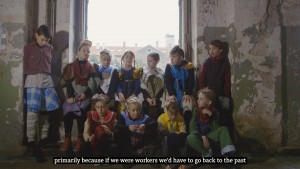
KK: I am curious about the kids themselves. The strength of their performances really comes through in the film. How scripted were their interactions? How much involvement did they have in shaping the project?
AT: Yes, the children, the actors, the artists, were very important part of this! Initially I had planned for a script to be written for the film, however we very quickly decided that the material that the children generated themselves was more compelling. All of the movement and vocalizations were either improvised on the spot or previously generated by the children, by the cast and with the help of the co-directors of course. We started this process with workshops and exercises. For example, we would share some historical information about the site and ask them to riff on that. They wrote fictional histories. They held debates about the future of the site. They imagined biographies of former workers and inhabited those biographies. Things like that. Guided situations to improvise within. Those situations were collaboratively developed over days of discussions and workshops. We realized that we would have to create an environment wherein, going into the filming time, the cast would have to be comfortable with the uncertainties of improvisation when the cameras were rolling. And they were!
You also asked about the script. We did not have a script, the children improvised or generated all the dialogue though our workshops which were sometimes quite guided and sometimes quite open ended. The material that we gave to the kids as script came from two particular sources. Firstly, there were statements transcribed in the 1980’s of the actual workers of the worker managed Rikard Benčić Factory about their collectives. The other source texts are current and very recent statements about the development and potential profitability of the site by power brokers like the mayor and the head of the department of culture. In these texts you have the soft propagandistic language of socialism, of the worker collectives in juxtaposition to the propaganda of late capitalism.
KK: Did any of the children have personal links to the Benčić factory site? How do you think that affected their performances and their engagement with the project?
AT: Yes, I think all of them did, or most. With the Rikard Benčić factory having been such a massive employer in the city, most of the kids would have had some kind of family member or someone close to their family who had worked there. We heard things come out, especially in the final debate scene that reflected this. Their investment in and affection for and ownership of the place—which had been developing over the weeks that we spent there of course—came out. In that scene when they speak about “former times” and how things need to be more like that in the future, I heard their parents and their grandparents speaking. That is something that we did not really anticipate. That scene was not rehearsed. Even though we had many discussions and smaller scale debates that prepared them in a way, I was surprised by the intergenerational tone of the voices passing through them.
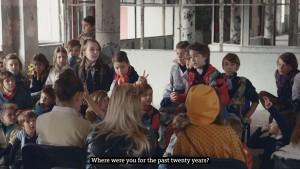
KK: I was struck by how much the film echoed recent factory take-overs, reclamations of space, and squats in the region and further afield. Here children are the main agents of the action. The film doesn’t just envision an alternate future, but actually places the very people who will be making the decisions in a future Rijeka at the center of the discussion. Even if it is only in the context of play-acting, the effect is powerful.
AT: Yes, they were participating in this civic conversation. For real. And with stakes. The conceit that I brought to the film was the framework or story of an occupation of former workers. These are political gestures that I had been familiar with as an observer but not directly involved in. In Vancouver, where I live, but also other places. I was a resident at the Künstlerhaus Bethanien in Berlin in 2005, for instance, when the second generation of squatters broke into the building and we attended some of their programs and discussions. I had also, several years ago, visited a few of the so-called recovered factories turned cooperatives outside Buenos Aries.
When I came to Rijeka, with all of these empty buildings owned by the city, as well as and many struggling artists and others needing community space, I kept asking people: Why is no one squatting? These places are publicly owned and in need of maintenance, what are they going to do? They were naïve questions. I realized that things are more complicated when you put yourself in an antagonistic position with the local cultural elite who are powerful and can manipulate the press, and that artists can easily get blacklisted. But there was also a culture of non-activism. I should note as well that it seemed to me that this was also a question of relationship with tradition, because we could understand the political action of occupying or taking back a factory to be a kind of traditional one. Especially in the former Yugoslavia. It is an effective and practical and possibly radical action, but also traditional and not necessarily innovative.
KK: The film really brings forward these dynamics. As a result it adds a lot to the conversation, especially through the children’s own conversations about occupation and re-claiming, building on the unique history of self-management in the former Yugoslavia in very creative ways. Tell me more about why you chose to tile the film: Preuzmimo Benčić?
AT: I wanted to say something about the way the term “preuzmite” constantly came up, not just with regards to the title of the film and the children’s actions, but many other things and conversations that were taking place. You could think of a notion of taking over, taking back, coopting, occupying, reclaiming, or inheriting in relation to worker self-management itself. Part of the ongoing process of how we were working as a cast and crew was that the decisions were generally made collectively or collaboratively, and that included the children. Of course I was the director and had the final say, so in that way perhaps it was a more realistic miming of worker management, which had bosses in the background. However, the intergenerational collective process was pretty functional in our project on a day-to-day basis. It was apparent right away that this was how the best work would get done and the best art would get made. Our process, having a relationship with the collective management of a factory to produce something of course draws on that historical analogy.
Also, there is the question of: What is being reclaimed? The children had a fascination and sentimental relationship with this young man, Rikard Benčić, the buildings’ namesake, as a figurehead, who you could understand as an enigmatic proxy for the aspirations of the nascent socialist state. He was a young worker in the shipyard, Matteo Skull, the mother factory of the new Benčić ship and machine parts factory. He then joined the partisans and was killed at the age of 22 or 23 in World War II. The way that the bio of the so-called national hero had been written and officially presented by the state was oddly compelling for the kids, who took that up in their letters to him, which also oddly resembled letters that children would write to Tito. On the other hand, in addition to rewriting the official history of the factory, the children also felt free to fictionalize his biography to fulfil their own imaginative fantasies. So in addition to histories and political organizing principles, certain aspects of stories and official narratives were also being taken over, and I think the title of the film refers to all this. The processes of the project both interrogated but also replicated particular propagandistic tendencies. These are questions that circle around many of the scenes and activities of the project.
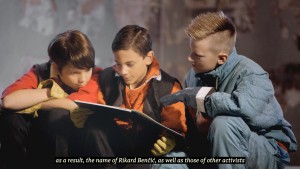
KK: It is interesting that, as you say, in some ways the child-actors were reproducing the roles of adults by reenacting intergenerational scripts. On the other hand, they are putting in all these unique twists and turns. That really comes out in their conversations as they slip between the words ‘worker’ and ‘artist,’ which consistently happens in the film. Whether art is work, if workers are artists, whether they are doing work or doing art. Are they playing or working? The slippages between these words are a fascinating part of the film. I am wondering how you saw that conversation developing and those slippages and whether or not they influenced your own views about relationships between these different terms.
AT: Yes! Very much so. This is something that myself and the other artists and directors I was collaborating with spoke about often. One of the amazing things about working with children actors is that inevitably when they are “working” they are always both in and out of a role. Their role in the film was something like “artist workers,” or “workers in former time” and their actual situation on set was something like “working artists.” So I think all of these slippages also relate to a kind of time jumping, or historical return. This is also related to questioning what we think is fundamental for artists, whose work is to make things seemingly out of nothing or with a great degree of freedom. What is the work that needs to be done? They are fundamental but urgent questions. In English and some other languages like German, the term “work” can apply to the labor and process of an artist, but also to the final product, the work of art. However it does not end there. You could then ask, what is the work that is done by the work? What is the work? It is kind of amazing when the kids take that on. I was also interested in how the language, the Croatian terms got used and provided openings through the language. The way words rad (work) and posao (job) were constantly used—denoting meditations on labor, tasks, problem solving, effort, functionality, even cognitive processes. Of course these terms also have historical and political resonances. It was also interesting how stroj and strojevi constantly came up—machinery—and how they conjured notions of the apparatus or dispositif. There was also their insistence and enactment of the invisibility or intangibility of those things: rad, posao, strojevi.
Of course these are important political and theoretical concepts of our time that get articulated through bodies, movement, voices, and poetry that the kids somehow innately related to and opened up. So with working with children I was hoping that we could posit an opening for these important questions. In a tangible way there are moments in the film that deal with that. For example, in a dance sequence, you have a story written by those two young dancers about a brother giving a factory to his sister. There are related issues of depiction of historical issues through abstraction and a kind of intangibility. These are big, meta-narratives related to historical dialectics of the Benčić factory and the city. That site of industrial production being passed from era to era, from the Habsburgs to the Hungarian port part of the Austro-Hungarian empire, to Italian and German fascist occupations, through socialism and late capitalism, and many more. The dancers show such caring about the place, and about passing it along, with one historical moment looking to another with such careful observation. It is so poignant to me especially in light of how neglected and shortsighted the recent vision is. But this is related to the discussion of work and art. The work of the art is the way they inhabit the process of dance through observation, speaking back to the work of the body in dance, describing exertion and movement itself. They are able to do this in a way that is so immediate. These explorations of the relations between work and art and play are the fundament of the project.
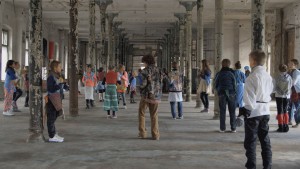
KK: In Rijeka, as in similar urban spaces across the region, we’re seeing a move away from the ‘producerist’ industrial worker – the mythology of industrial labor in the 20th century – towards a service-oriented economy, based on soft-skills, the ‘feminization’ of labor, increasing precarity, and other changes that we associate with flexible regimes of accumulation under neoliberalism. In your own experience, and for the kids in the project, how did this present postindustrial reality interact with the city’s industrial past? What struck you when comparing the present work being done by local people in the new supermarkets, retail chains, or the tourist economy, etc. with this past history of industrial labor?
AT: This is absolutely relevant! Except for their costumes, which they worked on with the designers, the production of the children in the project was intangible, immaterial — consisting of movements and vocalizations. I was really struck in some of our enactments by the way the children in the roles of workers spoke about their engagement with the material world. Your question about post-industrial economies brings me back to the way that the children spoke about machines, strojevi. They are either invisible, or they have disappeared from the factory, they are no longer there. This notion of the invisible apparatus, or apparatuses, and the ease and alacrity with which they were able to engage with and generate those notions was kind of surprising, interesting, even a bit disturbing at times.
You put it really well and of course those are things that we were thinking about continually and that form a kind of backdrop to the project. Those kinds of shifts and conflations, although they are a new kind of global normal, they are also quite specific in the region. Especially in Croatia, a country that has basically been sold, and where the tourist economy is dominant. With many people working in the service of foreigners, for the profit of foreigners, you have a particularly difficult, almost soul-destroying kind of precarity.
With regards to the site itself and intangible production, there is also the imagined promise of cultural industries and new creative start-ups. In terms of the way decisions are being made, and policies shifted locally and nationally, this is another ghost presence in the project. The department of culture has earmarked the Benčić site for this kind of “revitalization.” It is importing models from Belgrade or Berlin, which might be sexy but not necessarily successful in terms of supporting a local scene. Because of its plentiful industrial ruins assets that are so appealing as picturesque and cool backdrops to these new industries, Rijeka is being posited by the city itself as a new European ‘creative capital.’ The site epitomizes all of that.
And of course our project is completely implicated in these things. We had permission, from the department of culture, to do this work, which in a way could be used to support the agenda. We also had support from the Museum of Modern and Contemporary Art, who will be one of the key institutional anchors there. Under the direction of Slaven Tolj, who has been at the museum for the last two years or so, they are actually doing amazing work there, on a smaller and more realistic scale, opening the space up to projects like ours and to the independent scene. But I want to emphasize that our role in all of this is an implicated one, but also to propose, that perhaps perversely and poetically, by embodying the complexities and problems of the site we could open something up in a generative way, for real.

KK: You have already touched on aspects of this urban rebranding and revitalization that occurs in many post-industrial spaces, often by bringing in cultural industries and cultural capital. You have also motioned the gentrification and displacement that happens as a result of this kind of re-invention. How do you see these dynamics playing out in Rijeka in the wake of the project?
AT: They are complex issues, and of course I was drawn to the site and its redevelopment because I had been interested and involved in gentrification issues in other places. The local context in Rijeka is different than other places I had worked. On a policy level, the use of cultural development and cultural capital as a driver for development in the city, and as a way to increase profitability in real estate in the city is of course similar. There are processes of privatization and sale and reorganization of industries involving structural corruption that continue, and this causes fear, precarity, continuing job losses and displacement of the work force. In terms of displacement of communities through processes of neighborhood gentrification, it is not so much the case in Rijeka as in other cities in Croatia. At least not yet. There is so much empty industrial space in the city. If the plans to turn Rijeka into a cultural capital begin to be realized, of course this would change. In terms of the site and the project, the Benčić site has sat largely empty and deteriorating for over 20 years. There have been a few exceptions in the form of non-profits and independent art projects using parts of the space for periods of time over the years, but they were never allowed to stay. After the production of the film, the department of culture reworked the proposal to include a youth center in the development, which is something that one could maybe be very cautiously optimistic about.
KK: The work overall is very layered, shedding new light and questions on the economic restructuring taking place in Croatia. In conclusion I was wondering if you could provide some links or ideas as to where people can go to learn more about the factory or support local grassroots initiatives that are addressing some of these issues.
AT: Locally, in Rijeka, a lot has been written about the proposals for the site in the local press, most especially in Novi List. Some links to those articles are below, and I would encourage you to check out the reader comments at the end of the articles if you read Croatian (see here, here, here, and here). In terms of local grassroots efforts, in Rijeka, unfortunately, there are not a lot of resources out there. There have been some non-profit organizations as well as artist initiatives that have been able to use the space, but only temporarily, and this has not been well documented. Drugo More is an important independent art center that does critical discursive programming about the management of public space locally and in Croatia. Pro Torpedo is another local non-profit. They are concerned with the legacy and use of industrial heritage of the city. Much of their work is centered on education, but they also do advocacy work.
In terms of the former workers, there were no ownership shares distributed to them like in some other factories, there were no collectives formed after the dissolution of the Rikard Benčić Factory to represent their interests. Of course, this happened during the war, and the attrition in how the workers were fired was based on ethnicity, and this is still not something spoken about openly in the city. It is still a painful subject. The film I mentioned earlier, Rikard Benčić, naprimjer was produced by my friends and colleagues Nadija Mustapić and Marin Lukanović in 2008 tells some of these stories through interviews with former workers inside of the factory. It also describes former proposals for the space. It was influential for me in making the film but also in understanding this history.
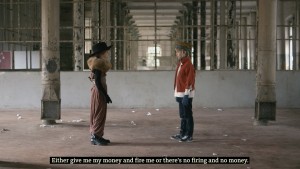
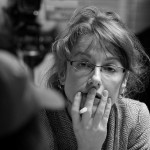 Althea Thauberger is a Canadian visual artist. Her internationally produced and exhibited work typically involves interactions with a group or community that result in performances, films, videos, audio recordings and books, and involve sometimes provocative reflections of social, political, institutional and aesthetic power relations.
Althea Thauberger is a Canadian visual artist. Her internationally produced and exhibited work typically involves interactions with a group or community that result in performances, films, videos, audio recordings and books, and involve sometimes provocative reflections of social, political, institutional and aesthetic power relations.
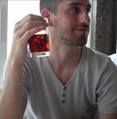 Konstantin Kilibarda (b. 1978, Toronto, Canada) is a PhD candidate in Political Science at York University. His dissertation addresses neoliberal restructuring in Montenegro and its impact on working lives and notions of citizenship in the newly independent state. His work also explores the links between postsocialist and postcolonial spaces.
Konstantin Kilibarda (b. 1978, Toronto, Canada) is a PhD candidate in Political Science at York University. His dissertation addresses neoliberal restructuring in Montenegro and its impact on working lives and notions of citizenship in the newly independent state. His work also explores the links between postsocialist and postcolonial spaces.


2 replies on “Work, Art, and Deindustrialization in Rijeka. An Interview with Althea Thauberger.”
Ce-i chestia asta cu cerinta de a fi logat cu un nume de wordpress.org la platforma CA pentru a putea posta comentarii pe CA?
Hurrah! After all I got a webpage from where I be able to in fact
obtain valuable information regarding my study and knowledge.